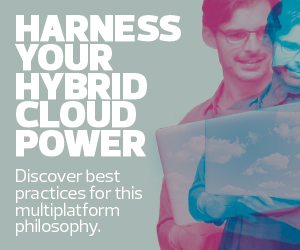The age of digital transformation is upon us, and hybrid cloud solutions are taking center stage in business operations. Hybrid cloud is an environment that blends on-premises, private cloud and third-party public cloud services. But does it really benefit organizations? Does it truly aid in sharing information and analyzing data as it claims to do?
Fact: Hybrid Cloud Makes It Easy to Scale Up or Down
For organizations of all types, managing the ebb and flow of data can be a major challenge. Certain times can see significant spikes in data traffic, as we see with seasonal or event-oriented businesses. In response, cloud services can be scaled up to manage increased demand, or they can be scaled down when demand is low. With its ability to adjust the number of resources used and the flexibility to use different types of services, hybrid cloud can be a great help in managing the ups and downs of data traffic. In fact, fifty-seven percent of organizations operating hybrid cloud environments have established cloud centers of excellence which are helping workflow management even more, according to a 2022 report by Cisco.
Click the banner to learn how to maximize the benefits of a secure hybrid cloud environment.
Fallacy: Hybrid Cloud Is More Cost-Effective Than On-Premises
While hybrid cloud can offer some savings, it’s not always less expensive. With hybrid cloud, cost-efficiency depends on several factors, including the business’s specific needs, the costs associated with migrating to the cloud, ongoing operational costs, and potential costs incurred due to security incidents or data loss. A thorough cost-benefit analysis is required to determine whether hybrid cloud is your most economical choice.
Fact: Hybrid Cloud Enhances Security and Compliance
Hybrid cloud can help businesses improve security and stay compliant with regulations and internal policies. For example, you can keep your most sensitive data in the private cloud, where you have full control over it and can apply strict security measures. Less sensitive data can be stored in the public cloud. With hybrid cloud, you can also easily control where and how you store your data to meet different regulations. Certain data can be kept in the private cloud to comply with privacy laws, while data that doesn’t have such restrictions can be stored in the public cloud.
Fact: Hybrid Cloud Environments Make It Easier to Share Data
Hybrid cloud allows different organizations and departments within organizations to easily share data. That’s because the data is stored in the cloud and can be accessed from anywhere, anytime. Besides just sharing data, hybrid cloud platforms also provide tools and applications that make working together easier. Multiple people can work on the same document at the same time or communicate instantly through the platform. This way, teams can collaborate on a project even if members are in different locations.
Fallacy: Hybrid Cloud Is Less Secure Than On-Premises Tools
This is a common misconception. Hybrid cloud provides layered security, so there are multiple levels of security measures in place. If one layer is breached, there are other layers that still protect the data. Additionally, hybrid cloud systems are typically managed by companies with a deep understanding of security risks. These companies dedicate significant resources to security — often more than a single business, even a large one, could provide on its own. They also regularly update security measures, ensuring that their systems are protected against the latest threats.
57%
The share of organizations operating hybrid cloud environments that have established cloud centers of excellence
Source: Cisco, “2022 Global Hybrid Cloud Trends Report,” May 2022
Fact: Hybrid Cloud Makes Data Analytics More Robust
Critics may argue that hybrid cloud makes data analysis more complicated because the data is spread across multiple platforms. In fact, hybrid cloud solutions enhance data analysis. By leveraging Big Data and artificial intelligence in the cloud, businesses can process and analyze vast amounts of data more quickly and efficiently. However, it’s important to note that the effectiveness of data analysis in a hybrid cloud environment requires proper data management strategies, including data integration and quality assurance.
Fallacy: Automation Is Complete with Hybrid Cloud
While automation in a hybrid cloud can reduce the workload and minimize human error, people still play a crucial role in many aspects of cloud management. Their knowledge, context awareness and decision-making skills are necessary to make the most out of the hybrid cloud system. Setting up and maintaining cloud management tasks require human intervention. In a hybrid cloud, orchestration is used to coordinate tasks across different parts of the system. Still, people often need to monitor them and step in if something unexpected happens.
Fact: Disaster Recovery Is Simpler in Hybrid Cloud Environments
With a hybrid cloud, data and applications aren’t all stored in one place; they’re spread across onsite servers, private clouds and public clouds. If an outage occurs, not all data and apps will be affected, and they can keep running without causing a complete shutdown. If data is lost, backups stored in the cloud can be quickly accessed and restored. Moreover, in a hybrid cloud environment, apps can be duplicated or mirrored across multiple platforms. If one platform fails, the other can take over, ensuring continuity of service.












